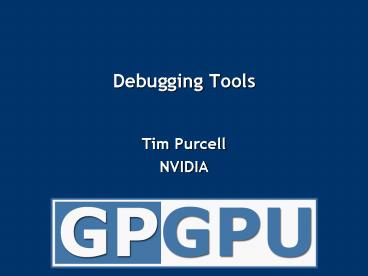Debugging Tools - PowerPoint PPT Presentation
1 / 31
Title:
Debugging Tools
Description:
Debuggers don't need to be fast. Should still be interactive. Easy to add to existing apps ... Microsoft Shader Debugger Tool. Apple OpenGL Shader Builder ... – PowerPoint PPT presentation
Number of Views:64
Avg rating:3.0/5.0
Title: Debugging Tools
1
Debugging Tools
- Tim Purcell
- NVIDIA
2
Programming Soap Box
- Successful programming systems require at least
three tools - Compiler
- Cg, HLSL, GLSL, RTSL, Brook
- Debugger
- Profiler
3
Ideal Fragment Program Debugger
- Automate printf debugging
4
printf Debugging
- MOV suspect register to output
- Comment out anything else writing to output
- Scale and bias as needed
- Recompile
- Display/readback frame buffer
- Check values
- Repeat until error is (hopefully) found
5
printf Debugging Examples
6
printf Debugging Examples
7
printf Debugging Examples
8
printf Debugging Examples
9
Ideal Fragment Program Debugger
- Automate printf debugging
- Intuitive and easy to use interface
- Features over performance
- Debuggers dont need to be fast
- Should still be interactive
- Easy to add to existing apps
- And remove
- Touch as little GPU state as possible
- Report actual hardware values
- No software simulations!
10
Debugger Features
- Per-pixel register watch
- Including interpolants, outputs, etc.
- Breakpoints
- Fragment program interpreter
- Single step forwards or backwards
- Execute modified code on the fly
- And save it
11
Debugger Features - Visualization
- Display register value at each pixel
- Color channel masking
- Arbitrary code for visualization
- Allows scale and bias of values
- Multiple visualization windows
- Visualize each source register and result
- MUL R2, R1, R0
12
Debugging Options Today
- Graphic Remedy gDebugger
- GLIntercept - D. Trebilco
- Microsoft Shader Debugger Tool
- Apple OpenGL Shader Builder
- Imdebug The Image Debugger B. Baxter
- Shadesmith T. Purcell, P. Sen
- Relational Debugging Engine Duca et al. 2005
13
GPU Vendor Debugging Options
- ATI RenderMonkey
- Nvidia FXComposer
- Wont talk about these today
14
Graphic Remedy gDebugger
- Pros
- Breakpoints, stepping
- Watch windows
- Performance analysis
- OpenGL 2.0
- Cons
- OpenGL only
- Currently no program debugging
- http//www.gremedy.com/
15
gDebugger
16
GLIntercept
- Pros
- Track all OpenGL state
- Runtime shader edit and recompile
- Resource tracking and management
- Cons
- OpenGL only
- No shader debugging
- No direct support for visualizations
- http//glintercept.nutty.org/
17
GLIntercept
18
Microsoft Shader Debugger Tool
- Pros
- Direct3D debugging integrated into Visual Studio
IDE - Full featured
- Assembly and high level debugging
- Vertex and fragment programs
- Watches, breakpoints, etc.
- Cons
- Only works with software rasterizer
- Slow and painful
- D3D only
- Shader changes require recompilation
- http//msdn.microsoft.com/library/default.asp?url
/library/en-us/directx9_c/directx/graphics/Tools/S
haderDebugger.asp
19
Apple OpenGL Shader Builder
- Pros
- Integrated development environment
- Handy reference guide, resource manager
- Texture editor
- On the fly edit and display of shader changes
- Cons
- Canned geometry
- Basically a shader tool (in the traditional
sense) - not GPGPU debugger
- ARB vertex/fragment programs only
- No vendor specific GL extensions support?
- http//developer.apple.com/graphicsimaging/opengl/
shader_image.html
20
imdebug
- Printf-style debugger
- imdebug("rgb wd hd p", 16, 17, testRGB)
- Readback memory (texture/frame buffer) and
display in image window - http//www.billbaxter.com/projects/imdebug/
21
imdebug
22
imdebug
- Pros
- Simple addition of single printf-style statement
to programs - Displays hardware computed values not software
generated values - Scale and bias
- Source available for download
- Cons
- Cant breakpoint shaders
- Can only watch what shader outputs
23
Shadesmith
- Debugger in the spirit of imdebug
- Simply add a debug statement when binding shaders
- Display window with scale, bias, component
masking - Advanced features
- Can watch any shader register contents without
recompile - Shader single stepping (forward and backward),
breakpointing - Shader source edit and reload without recompile
- http//graphics.stanford.edu/projects/shadesmith/
24
Shadesmith Implementation Insight
- Only one register modified per instruction
- Ignore CC for now
- Decompose fragment program into several smaller
programs - One program per assembly instruction
- Save register state on host
- Iterative deepening decomposition
25
Iterative Deepening
... ADD R0, R1, fWPOS MAD R1, R0, R2, R3 TEX
R2, R1, TEX0, RECT ...
26
Iterative Deepening
... ADD R0, R1, fWPOS MAD R1, R0, R2, R3 TEX
R2, R1, TEX0, RECT ...
... ADD R0, R1, fWPOS MAD R1, R0, R2, R3 MOV
oCOLR, R1 END
27
Iterative Deepening
... ADD R0, R1, fWPOS MAD R1, R0, R2, R3 TEX
R2, R1, TEX0, RECT ...
... ADD R0, R1, fWPOS MAD R1, R0, R2, R3 TEX
R2, R1, TEX0, RECT MOV oCOLR, R2 END
Later code more expensive than early code
28
Basic Shadesmith Flow
- Decompose program into smaller programs
- Use iterative deepening approach
- Run programs required to determine watch values
- One program per value watched
- Readback modified register to host
- Via glReadPixels()
- Display register values per pixel
- Visualization windows
- Per-pixel values on mouseover
29
Relational Debugging Engine
- Build database of GPU state
- Including pipeline state, shader state
- SQL-like queries generate visualizations
- Including vertex programs
- Raw text output available as well
- Built on top of Chromium
- Can debug any OpenGL application without
recompilation - Current system assumes Cg shaders
- Approach is applicable to other GPU languages
30
Relational Debugging Engine
31
Relational Debugging Engine
- Sketch Thursday 145-330 Room 515A































